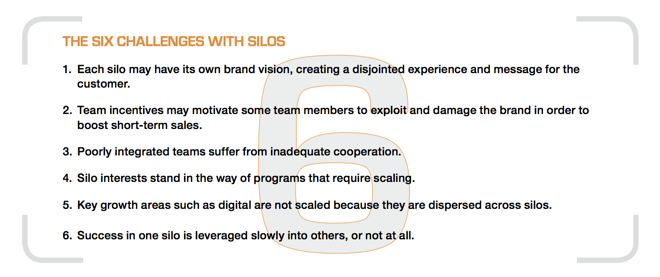At a time when consumer landscapes are shifting more rapidly than ever before, budgets are continually being evaluated, and marketing is under scrutiny.
Communication and collaboration are vital.
CMOs and senior leaders in B2B or B2C marketing departments are under intense pressure to find ever-better ways to enhance collaboration, as individuals and agencies work in their distinct roles.
Traditionally, marketing was siloed to allow companies to benefit from expertise in an increasingly diverse range of channels.
This approach has proven viable for small businesses but as a business grows, these kinds of divisions can be the enemy of collaboration.
They can prevent functional teams from pulling together towards the best outcomes.
Think of it in terms of Enterprise SEO and PPC – we know they work better together, but how do you get the two teams working cohesively and sharing data?
What Taking a Siloed Approach Means for Your Marketing Strategy
Consistency is very much key in marketing, where the constantly-connected customer wants to see the same tone and style across channels.
Having teams working in isolation from one another creates inconsistencies with the brand strategy and misaligned messages, resulting in a disjointed and off-putting experience for the customer.
Siloing teams can also have the effect of pitting them against one another as they compete for short-term sales gains rather than focusing on more long-term strategies, which could damage the brand.
This kind of competitive environment not only means that opportunities are lost but that work cultures become unfriendly, political, and demoralizing.
Just like with SEO, other marketing disciplines should be adopting a more holistic mindset.
Teams that fail to achieve the same objectives miss out on vital growth opportunities and the incremental gains that are best realized from more integrated campaigns.
When people work in silos, there’s no single view of the customer.
Understanding the overarching customer journey and each team member’s place in it is critical.
A lack of clear communication and a reluctance to share information between parties can result in lost time and delayed projects, and ineffective campaigns.
Departments scramble to collect information that others already have, which creates a redundancy or disregards the data entirely.
In short, a lack of collaboration can put the business at risk.

Pros & Cons
On the other hand, cross-functional work involves bringing data, insights, creativity, knowledge, experience, and media together to maximize business success and provide the best possible experience for the customer.
This kind of integrated marketing enables the team to provide oversight of a project from start to finish, which makes managing it smoother and more efficient.
Employees benefit from being able to see the bigger picture, which helps them to become more invested and find increased opportunities to grow their skillsets.
The benefits extend beyond marketing to its success inside the larger organization, as well.
Having shared goals and regularly sharing information in pursuit of these goals improves marketing visibility and credibility.
5 Ways to Break Down Marketing Silos & Be More Effective
1. Establish Shared Goals
Departments need to have their own and shared metrics, with key performance indicators (KPIs) to enhance the brand and customer relationship.
Too often, goals are tactic or channel-specific, and teams end up competing against one another.
Shared goals immediately create common ground and provide the basis by which multi-disciplinary teams can begin to understand the bigger picture (and their place within it).
2. Structure Your Team for Success
The way you structure teams can be impactful.
Ten years ago, you likely had a creative team and an analytics team completely separate from one another.
Now, you’ll find creativity and analytical thinking in the same teams or projects – indeed, within a single employee.
Make sure you have these bases covered and that each team member understands their role.
It helps that they know the strengths of other team members, as well. Who can they turn to for a specific type of question or help request?
3. Create Common Marketing Data Resources to Empower Decision-Making
Using workflow and collaboration software, you can create repositories of assets and resources to better inform cross-functional teams.
Performance reports don’t necessarily need to be presented to the team; they can be made available inside the project and discussed in brief.
Image assets, shared information, creative briefs, project plans, and more can proactively provide insights that get all on the same page, rather than leaving them to chase one another for information.
4. Have a Master Marketing Plan That All Team Members Can Access
The core understanding that drives all of the working parts of a project or campaign lives at the top, but it doesn’t need to stay there.
Eliminate the “my department” mentality by inviting all team members to view, discuss, and ask questions about Marketing’s overall goals and messaging themes on a monthly and quarterly basis.
The days of holding your cards close to your chest and only sharing bits of information here and there are long over.
Today, multi-disciplinary teams work best when PPC understands what its place is in the campaign and why, and when SEO knows the gaps PPC is filling and how all of this together moves them closer to the collective goal.
5. Prioritize Marketing-Wide Meetings and Cross-Training
No one likes sitting in meetings for hours listening to information that’s irrelevant to their work.
However, it’s essential to strike a balance and ensure the entire team has at least a basic understanding of their place in the bigger picture.
Understanding what others are working on and even learning some of what they do helps team members develop empathy and see how they are working together to support shared goals.
Keep all-hands meetings brief and relevant, and consider skills sharing sessions as not only education but team-building exercises, as well.
Conclusion
As organizations take a more agile approach to business, the same applies to how teams (including marketing) work together towards channel and overall business goals.
Performance depends on consistent collaboration and communication.
We’ve long known that breaking down silos is integral to the success of omnichannel campaigns. It’s important to recognize, too, that integrated teams and campaigns better support each team member and their performance.
People no longer consume media in silos, so as marketers, we should not be creating and running our campaigns in them, either.
More Resources:
- Enterprise SEO in 2021: The Importance of Insights & Value of Action
- Top 5 Challenges of Enterprise SEO
- Enterprise SEO Guide: Strategies, Tools, & More
Image Credit
Image 1: Forbes Insights





